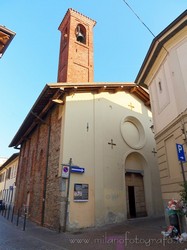|
Vimercate (Monza e Brianza, Italy): Oratory of Sant'Antonio
|
|
|
Show an other place around Milan worth a visit: |
 The Oratory of St. Anthony is located in the street that in its first part follows the first stretch of the Roman road to the east. It is a small very simple church built in the Visconti era, with a gabled façade characterized by a rose window today closed. The north side of the church has a wall fabric that alternates bricks and river pebbles, a typical structure of the thirteenth century. The Oratory of St. Anthony is located in the street that in its first part follows the first stretch of the Roman road to the east. It is a small very simple church built in the Visconti era, with a gabled façade characterized by a rose window today closed. The north side of the church has a wall fabric that alternates bricks and river pebbles, a typical structure of the thirteenth century.
There is also a small bell tower added at the beginning of the seventeenth century. The two bells are original and bear the date of 1673 together with sacred writings with the words Panem angelorum- and - et Deus homo factus est.
Originally the oratory included, in addition to the nave, an apse on the bottom. The internal arrangement consisting of transversal arches with pointed arches starting from semi-pilasters on the wall is due the second half of the fifteenth century. In the first half of the seventeenth century the original apse was replaced with the current deep rectangular apse with choir. At the center of this new apse was put the large baroque altar.
The church was never part of a monastery, instead it was the Oratory of one of the many Schole. The Schools were confraternities, or pious lay associations, with religious and charitable purposes.
On the northern wall of the oratory there are numerous fragments of a cycle of frescoes with Stories of the Passion of Christ (Fig. 2, 3), which date from 1460-1480 and which were probably made by a late Gothic workshop strongly influenced by the style of the Zavattari who had worked in the chapel of Teodolinda in the Cathedral of Monza. Originally it had to be a cycle of frescoes organized in panels, a typology typical for the time and which functionally reminds modern comics. In particular it is possible to recognize an Adoration of Magi, a Flagellation and a Crucifixion. It should be noted that the windows on the wall were added after the frescoes, which were so irreparably mutilated already long ago.
There are also other votive frescoes, albeit of lower quality, including a sinopia with The Adoration of the Magi of the same period and, in particular, on the south wall, a fragmentary Madonna with Child from the early sixteenth century.
On the counter-façade there is a large seventeenth-century painting depicting The Glory of San Carlo (Fig. 4), a work of the Lampugnani brothers, painters native of Legnano and frequently operating together. The painting depicts the holy Milanese archbishop ascending to the sky, while extending a hand downwards, where, under the layer of clouds, a detailed view of the village of Vimercate can be recognized, as seen by a flying bird.
The wooden altar is dominated by the large altarpiece on canvas, an oil painting, depicting Our Lady of Sorrows surrounded by angels; in the foreground on the left there is Saint Anthony Abbot who opens his arms in prayer and has at his feet an open book and a stick; a putto holds a skull; on the right, with a twilight landscape as background, is depicted Saint Christopher bearing the Child. In good state of conservation, this canvas seems to be the work of a local painter executed at the end of the eighteenth century.
There is also a small sacristy, from which, through a ladder, it is possible to access the wooden balcony, at the bottom right of the nave, on which there is also a currently not used seventeenth-century organ.
Categories: Places of historical value of artistic value
Via S. Antonio abate, 1, 20871 Vimercate MB |
Further pictures of Oratory of Sant'Antonio in the section Photography |